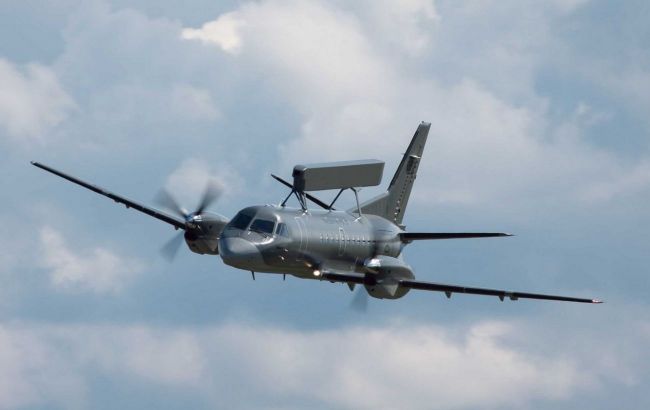Swedish ASC 890: How they will change rules of game and complement F-16
 Photo: Sweden will transfer ASC 890 aircraft to Ukraine (x.com/Defence_IDA)
Photo: Sweden will transfer ASC 890 aircraft to Ukraine (x.com/Defence_IDA)
Ukraine will receive a long-range radar detection aircraft for the first time since independence. Today, the Swedish government announced the future transfer of the ASC 890, also known as the Saab 340 AEW&C or S-100B Argus.
More details on this historic decision, why it's a real game-changer, and how Swedish AWACS will impact the course of the Russian-Ukrainian war can be found in the material by RBC-Ukraine.
Contents
- What Sweden to transfer and why it's a historic decision
- What is known about the Swedish ASC 890 aircraft
- What they are capable of in combat situations
- When Ukraine can get Swedish AWACS
- How this game-changer will enhance Ukraine's capabilities
What Sweden to transfer and why it's a historic decision
The Swedish government has announced a significant military aid package worth $1.3 billion. It is reported to include:
- The entire fleet of PBV 302 armored personnel carriers (239 units according to The Military Balance)
- Ammunition and technical support for previously provided equipment
- Surplus tanks (without specifying type and quantity)
- Funds to support various coalitions and initiatives for equipment procurement
- Rb 99 guided missiles (licensed version of the AIM-120 AMRAAM)
However, the main headline revolves around the airborne surveillance and control aircraft ASC 890.
"ASC 890 will provide Ukraine with a new capability against both airborne and maritime targets. Ukraine's capability to identify targets at long range will be strengthened. They will act as a force multiplier with the introduction of F-16," stated Swedish Defense Minister Pal Jonson.
Notably, he used the word "they" in the plural form. According to Swedish media reports, the Ukrainian side will receive two aircraft. The terms of the transfer are currently unknown.

Photo: ASC 890 aircraft (flickr.com)
In any case, this is a truly historic event for Ukraine.
"In the Soviet Union, there were aircraft for radar detection, but when it collapsed, we didn't get such machines. Therefore, we were doomed to monitor the airspace only with the help of ground radars," explains aviation expert Valerii Romanenko.
Indeed, this is why Russian Shaheds and cruise missiles occasionally strike targets, despite being covered by anti-aircraft complexes. This is because there are gaps in their detection capabilities at low altitudes.
On the other hand, aircraft can "see" everything in the air and are specially adapted at the software level to distinguish targets against the background of the earth. For example, an enemy aircraft at a distance of 200-250 km or missiles at 150-200 km.
"With the acquisition of Swedish AWACS, we are practically becoming a country with full-fledged air defense," he added in a conversation with RBC-Ukraine.
What is known about the Swedish ASC 890 aircraft
Regarding airborne surveillance and control systems, the abbreviation AWACS is commonly used in Western terminology.
ASC 890 (Airborne Surveillance and Control) is an airborne combat platform for management and air surveillance. It is a Saab 340 aircraft with a long-range radar on the roof. Besides Sweden, they are also operated in Thailand and Poland.
The Saab 340 is equipped with two turboprop engines and has the following characteristics:
- Length: 20.57 meters
- Wingspan: 21.44 meters
- Height: 6.97 meters
- Maximum takeoff weight: 13,155 kg
- Maximum speed: 530 km/h
- Service ceiling: 7,620 meters
- Flight duration: up to 7 hours
The Saab 340 aircraft itself is not something new for Ukraine. Civilian versions have been used, for example, by the Motor Sich airline, as noted by Romanenko.
The main feature in the version for the Air Force is the presence of the ASC 890 system, which uses Active Electronically Scanned Array (AESA) technology. It allows dynamically adjusting the radar's energy depending on the situation. The radar is capable of covering a wide area or focusing on a smaller priority zone with high update rates.
The S-band technology ensures high performance in various weather conditions. The effective surveillance range includes over 500,000 square kilometers horizontally and over 18,000 meters vertically. The system detects and tracks objects such as fighters, cruise missiles, hovering helicopters, and even sea targets the size of jet skis.
These systems began operating with the Swedish Air Force as early as 1996 but underwent modernization. They are considered quite modern long-range reconnaissance assets.
In the 2000s, there were even talks of installing Swedish systems on Ukrainian An-140, An-148, and An-158 aircraft, according to aviation expert Kostyantyn Kryvolap. Later, there were discussions about Swedish radars and Russian equipment, but it all ended there.
"The radar itself, computational capabilities, and equipment in the ASC 890 are quite modern. It's a good machine. And it sees the target 100% better than the Russian A-50U," he noted.
For comparison, the Russian radar constantly rotates 360 degrees. In Swedish aircraft, the fixed radar provides quality coverage for 400-450 km at 150 degrees. The only problem is the dead zones in front of and behind the aircraft. But with electronic switching, beams with the necessary characteristics can be directed where needed, Kryvolap added.
Sources tell RBC-Ukraine that Sweden is transferring its aircraft because it is transitioning to new developments. But they are not significantly inferior and are still capable of much.
What they are capable of in combat situations
Airborne radars transmit information to central and local command centers, as well as provide direct targeting for combat aircraft. In the case of Ukraine, they will truly unleash the potential of multi-role F-16 fighters, which are expected in the summer.
"So, the F-16 pilot will not hear it but will see it on the tactical situation screen, which targets to pursue, at what distance, which weapon to use, and how best to approach the target - using active or passive systems. For example, with passive systems, you can approach the enemy fighter so stealthily that it won't even notice it," explains Valerii Romanenko.
Data is transmitted through the tactical Link 16 network, used by the USA and NATO countries. This communication, navigation, and identification system support data exchange between command, aircraft, ships, and ground forces at ultra-high frequency.

Photo: ASC 890 aircraft are capable of providing targeting not only to combat fighters but also to ground-based air defense systems. (x.com/PlJonson)
Figuratively speaking, information from Link 16 transmitted from the ASC 890 aircraft goes to the fighter jet, from there to the missile, and "off it goes," says Kostyantyn Kryvolap. This cannot be done with Ukrainian MiGs, which is why AWACS are more relevant for F-16.
Moreover, not only combat aviation can receive targeting.
"Practically anything you need. ATACMS missiles (launched from HIMARS MLRS), Storm Shadow aviation missiles, ground-based air defense systems, and all missile armaments. America and Europe don't fly without their AWACS," he emphasized.
Romanenko calls Swedish AWACS universal machines. They allow not only for the control of anti-aircraft complexes and air defense in general but also for electronic warfare (EW) means.
When Ukraine can get Swedish AWACS
It is currently unknown when Ukraine will receive the ASC 890 aircraft. The timelines depend on how quickly personnel can be trained. The crew consists of six people - two pilots and four radar station operators.
According to Romanenko, the news from Sweden only marks the beginning of the preparation.
"Pilots can be trained in approximately 2-3 months, as we have many pilots who have flown on the Saab 340. Regarding the operational crew, the officers of the combat control, it is probably enough to retrain operators of ground systems. This may take 3-4 months," says the interlocutor.
There is no need to separately prepare the aircraft for operation in Ukrainian conditions. Their systems are integrated with NATO's, and in the case of Western equipment models and the same F-16, there is no need for additional modifications, says Kryvolap.
"But I don't think the ASC 890 will appear very soon. After all, the crew needs to be trained, time is needed to master the radar operation. I don't know how it will be, but such aircraft are very necessary for us," the expert added.
How this game-changer will enhance Ukraine's capabilities
Experts surveyed by RBC-Ukraine outline several ways in which the ASC 890 will be applied, primarily focusing on continuous monitoring of Ukrainian airspace.
For example, during a massive Shahed attack, signals from long-range detection aircraft will allow mobile groups to react promptly to shoot down the attacking drone with machine guns rather than expensive missiles. The same goes for cruise missiles. Self-propelled anti-aircraft systems will be able to move tens of kilometers within half an hour and intercept the missile. "This opens up new possibilities for our air defense," says Romanenko.
According to him, there is a belief that Swedish AWACS will not be based on Ukrainian territory.
"At least, this aspect is being discussed. Because the Russians won't hesitate to use any missiles to destroy them. Because it's a game-changer that completely changes the rules of the game. Moreover, if we're talking about two aircraft. Two aircraft would fully cover the southern and southeastern directions, where most missiles and Shaheds fly from," the expert explained.

Photo: Swedish aircraft could become a real game-changer in the Russian-Ukrainian war. (flickr.com)
As for aviation, the ASC 890 is capable of detecting and providing targeting for Russian tactical aircraft at a distance of 300 km. This means that it needs to approach within 250 km of the front line, as enemy Su-34s launch guided aerial bombs (KABs) from 50 km away.
The problem is that Russian anti-aircraft systems may be positioned at roughly the same locations, practically guaranteeing the ASC 890's vulnerability to ground-based and air defense systems.
"So, they won't be able to target aircraft with KABs anyway. But strengthening our air defense - yes. We will move to a qualitatively new level. With their help, the percentage of drone and missile destruction will approach 100%. Besides ballistic threats, they are helpless against ballistic missiles," added Romanenko.
Kostyantyn Kryvolap believes that the ASC 890 will be used very cautiously to avoid being targeted by the S-400 and aviation missiles with the claimed but unconfirmed range of 300-400 km.
"How to deal with this? Probably, our specialists will find tactical maneuvers to ensure security and get as close to the front line as possible to have a better view of the situation," the expert added.
According to his calculations, the ASC 890 will hypothetically cover the entire line of contact over the Cherkasy region. If over the Odesa region, it would extend about halfway into occupied Crimea. It's unlikely to approach the front line due to the high risk of being targeted.
If we consider a safe radius of 400 km, this would be sufficient to observe Russian aircraft not only when they take off from airfields in the Voronezh region, Kursk, or Belgorod but also while they are still on the airfields.
"Of course, the ASC 890 itself cannot engage Russian Su-34s with KABs. But they will provide targeting for F-16s to launch missiles at enemy aircraft without entering their visibility zone," concluded Kryvolap.
Sources: information from open sources, a statement by Swedish Prime Minister Pal Jonson, comments from former test engineer at Antonov Design Bureau, Kostyantyn Kryvolap, and leading researcher at the National Aviation University of Ukraine, Valerii Romanenko.

